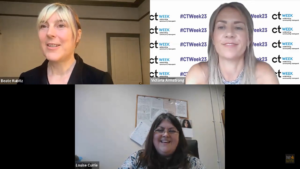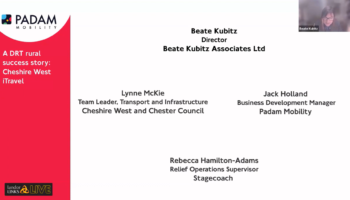
The recent webinar on Community Transport and DRT threw up some interesting questions. It focused on The Robin in the Forest of Dean, operated by community transport operator Lydney Dial-a-Ride and was hosted by Victoria Armstrong, CEO of the Community Transport Association (cta). Louise Currie from Lydney Dial-a-Ride provided insight into the community approach to running a sophisticated DRT operation, with metrics provided by independent transport consultant Beate Kubitz. We selected some commonly asked questions from the chat and outlined our replies below.
How did you promote the new service to everyone? We also have an older generation mainly in the area and have already had some passengers concerned about the DRT system to be implemented.
Working with a CT operator has been great for this. Lydney Dial-a-Ride already has good understanding of this group and in the webinar Louise outlined her approach to getting people on board. The data shows that we have seen great uptake from this demographic across app and call centre usage.”
I think a key metric when evaluating DRT is passengers carried per hour (or, to avoid issues with variations in distance, passenger boardings per hour). Would you agree that, if the result is lower than can be provided on a fixed route, the funds would be better spent on traditional fixed route (or timed many-to-one DRT) service?
We look at patronage per revenue our as a metric and want to grow this. However fixed line services would not be able to serve such a diverse range of destinations as the DRT where the virtual stops do not have to be distributed along linear routes and can provide for people across the area. Serving the same stops by fixed route would be very expensive . DRT provides more accessibility for more people. To improve value we try and design systems to carry people to a central hub, allowing them to make an onward journey on a bus or train. Also, in places where there is a fixed route service, there is an option to direct people towards the fixed route and ensure that DRT does not compete with routes served by commercial services.”
How can passengers guarantee a trip for a fixed arrival time, e.g. for medical appointments?
The Padam Mobility software that sits behind the DRT offers both a “depart at” and “arrive by” option when journeys are booked. We approach DRT from a public transport approach rather than a ride-hailing / taxi approach. This means that the arrival time is “locked in” after booking and is the latest time that you could arrive, inclusive of any other users that you share your journey with.”
Why does it have to be to bus stops – why can’t it be door-to-door?
Whilst it’s possible to run a door-to-door service, we’ve found that services with virtual stops work more efficiently. Virtual stops increase patronage rates as you are asking people to congregate at virtual or physical bus stops. Otherwise you could theoretically use a large amount of the flexible journey time stopping at each house on a street rather than a single collective stop. Also stop to stop services helps DRT distinguish itself from other services such as dial-a-ride that may be door-to-door given mobility needs of users.”
Is completely flexible DRT really sustainable? Some commentators suggest that many-to-one services (e.g. Petworth Route 99, Wiltshire Connect (ex-Wigglybus)) may stand a better chance (as has been proven over many years).
Semi-flexible DRT can help drive higher loadings but not all rural areas have population densities that can support this. Flexible DRT does have some place in the more isolated areas of the country, but can operate as a feeder service to key hubs, such as transport interchanges and town centres. The services in Gloucestershire and in Hertfordshire support this observation where 15-20% of trips start or end at rail stations.”
This article might interest you as well: DRT & Transport Consulting – Webinar with Xuefei Wang, Jack Holland and Chris Hillcoat – Q&A



